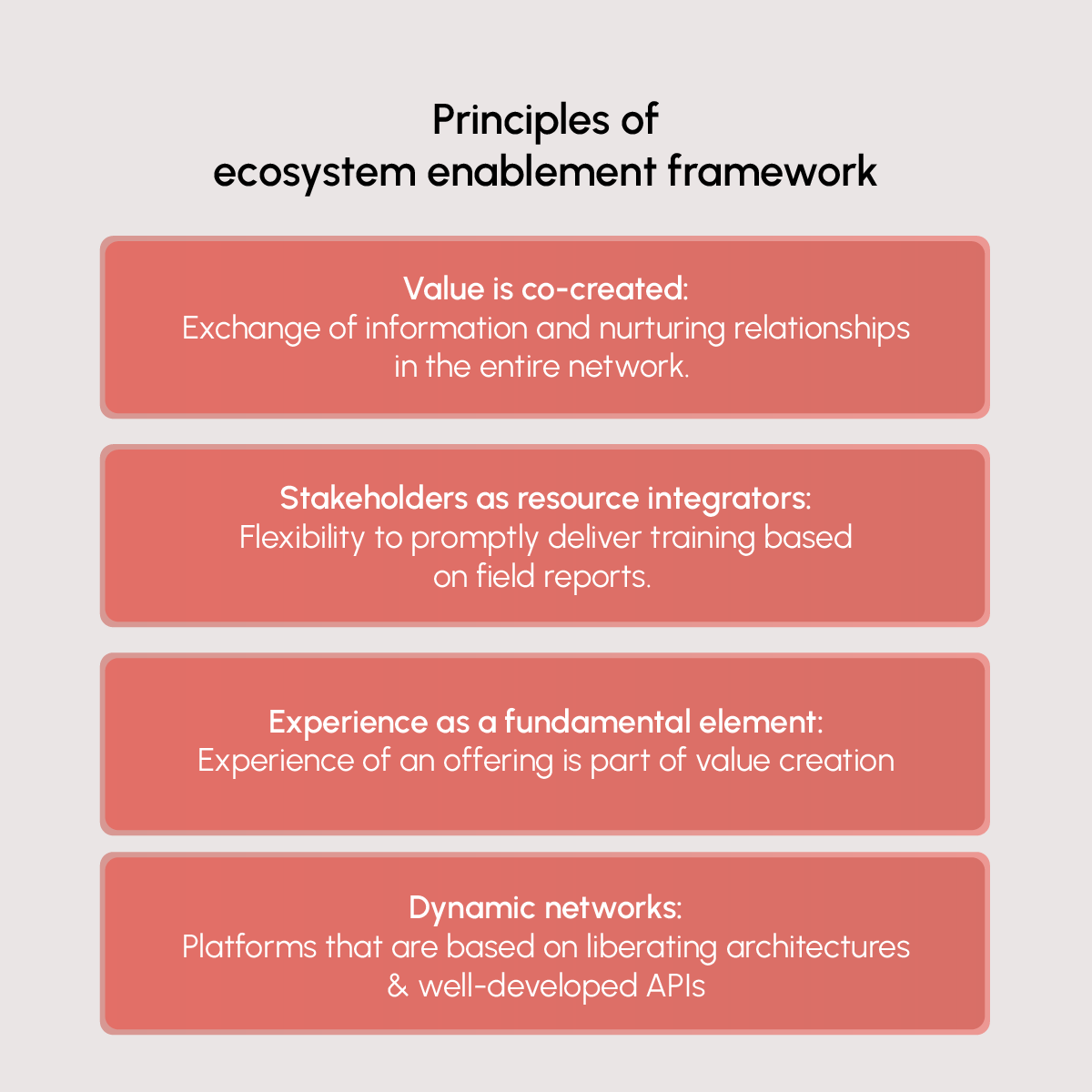From operations to outcomes: Building service ecosystems with MLM software

How modern MLM platforms create interconnected value networks
The multi-level marketing or the direct selling industry is at a crossroads in the current moment. Earlier, MLM software was seen as a tool used for processing transactions and calculating commissions. However, the shift in paradigm is that MLM software is now the key operational connection of a large network.
This whitepaper presents a new way of looking at the software, not just as a tool but as a way of creating value through networks of distributors, customers, corporative teams, and partners. Moving away from focusing merely on software components and focusing more on the actual outcome, companies can vastly advance their growth and distributor satisfaction.
The most successful MLM organizations are no longer using technology as an addition to their business model, it is the center of their business operations. Such a change creates a need for new KPIs, leadership practices, and organizational culture, all of which are discussed in detail here.
Based on the analysis of data collected from industries and case studies, this whitepaper provides crucial insights to MLM executives and technology experts on how the software can be effectively implemented and evolved in a consistent manner.
The evolution of MLM software
There is no doubt that the field of multi-level marketing has evolved dramatically over the past decade. The once face-to-face business that used paperwork for all documentation has now transpired into a technological business environment. Now, technology forms the spine and the circuitry of all major operations.
In the beginning of MLM software evolution, the needs of most companies were simple: track orders, calculate the compensations, and store the records of the distributors. In fact, these systems were created with a product emphasis for processing transactions and record keeping. Although these solutions were revolutionary in their time, they did not engage the distributors and customers as partners in the creation of value in a network. They were treated as passive recipients.
Today's market demands more. New challenges have introduced more pressure on businesses due to social selling, mobile commerce, and globalization. Today’s distributors are not expecting technology to merely calculate commissions. They require these platforms to create businesses, unify communities, and deliver valuable customer experience.
From product-centric to relationship-centric technology
Traditional methods in MLM software development were determined more by the type of features and opportunities. Uptime statistics, performance, and technical specifications were regarded as measures of success. Even so, those measurements were not sufficient to capture the essence of the MLM technology, which is to deliver value to the distributors, clients, and teams.
The revolutionary approach introduced in this whitepaper gives MLM software a new context of inter-connectedness that is as follows:
The distributors work together with other distributors and customers with regard to products and services.
Corporate teams act more as mediators and not as regulators of business processes.
Software becomes dynamic, responding to the changes needed by stakeholders in relation to the software.
Values are based on results and connections as opposed to a quantitative approach that is commonly based on volumes.
This view is a total shift to how MLM organizations handle investment in information technology, its deployment, and its change. It means that there is a need for change in measurement tools, leadership theories, and organizational perspectives.
MLM software as an ecosystem enabler
Redefining the role of technology in direct selling
The conventional view of MLM software is based on the application’s ability to perform certain tasks: commission calculations, management of inventory, orders placement, and distributor monitoring. Despite the emergence of new platforms, these capabilities still serve as the basics of what current virtual platforms must offer.
This is because when we harmonize MLM software with our understanding of ecosystem, we understand that its function is not to do something but to facilitate others to do it. Such a shift of focus changes the organizations’ view on technology adoption, deployment, and development.
Core principles of the ecosystem enablement framework

Value is co-created, not delivered
In the ecosystem model, software does not just make an output from a service provision viewpoint for the users; it encompasses a platform upon which distributors, customers and the corporate teams add value together. This implies that to succeed in the MLM environment, the platforms must include functions beyond the basic ones. These should enable communication, exchange of information and nurturing relationships in the entire network.
All stakeholders are resource integrators
All parties in the MLM solution system, including distributors, consumers, corporate employees and the technology partners, have something to contribute. Advanced MLM software should be able to assist each of the stakeholders successfully fit into the others’ ability sets. Thus, it could mean facilitating distributors to present products differently based on client information or giving the corporate team the flexibility to promptly deliver training based on field reports.
Experience is fundamental, not supplemental
Typically, functional requirements of the software system design process put little emphasis on experience. An important and critical factor in the ecosystem view is that the experience of an offering is part of value creation. What distributors’ experience when interacting with the software, (empowered, connected, and supported), translates into the capability of distributors to successfully create businesses and add value to customers.
Networks are dynamic and evolving
Dynamic features of an MLM model refer to the changes that usually affect an organization in any one MLM system. This can be due to the dynamics of distribution, the customers who are usually involved, and the existing market conditions. Thus, MLM software must not only be developed for the network as it is today but also with respect to how it will be used in the future. This in turn demands platforms that are based on liberating architectures and well-developed APIs, which are based on a modular system.
The ecosystem component model
It is possible to propose an ecosystem component model, which will create the following changes in the traditional MLM software structure:
| Traditional Function | Ecosystem Component | New Purpose |
|---|---|---|
| Commission Calculation | Value Distribution System | Incentivize behaviors that strengthen the ecosystem |
| Customer Relationship Management | Connection Facilitation Network | Enable meaningful relationship development |
| Inventory Management | Resource Availability Engine | Ensure the right resources are available to the right people at the right time |
| Reporting | Ecosystem Intelligence Platform | Provide actionable insights that help all stakeholders create more value |
| Training Systems | Capability Enhancement Network | Continuously develop the skills needed for ecosystem success |
This shift of focus is not just on terminology, it leads to significant changes in the development, management, and evaluation of these systems. For instance, most of the time we think of commission systems as nothing more than calculation systems, but if we consider them as value distribution systems, then the kind of questions we ask changes.
In which way shall our commission promote an environment that encourages behaviors that are beneficial for everybody involved?
Are our incentive programs well-aligned with collaboration and the objective of providing customers’ value?
To what extent can we modify incentives to respond to the challenges of ecosystems?
Measuring ecosystem health through distributor engagement
Beyond conventional metrics
Success factors fundamental to traditional MLM business model revolved around quantitative measures. This includes the turnover, the number of people enrolled, commissions paid, and sales and retention ratios. Although these factors are crucial, they only denote a certain status of the ecosystem. Modern systems based on the ecosystem approach should focus on qualitative data that describe the exact nature and depth of stakeholder interaction.
A multi-dimensional measurement framework
It’s better to have a measurement system that analyzes ecosystem health in four different dimensions:
Connection density
How often appropriate interactions occur between distributors and customers.
Joint activities among distributors.
Corporate department and field cross-functional integration.
Metrics: Interaction rate, collaboration frequency, knowledge sharing frequency.
Value flow dynamics
How fast and efficiently value flows between the ecosystem participants.
Value evenly distributed among all participants.
Metrics: Patterns of commission distribution, customer satisfaction across distributor segments, new distributor time-to-values.
Adaptive capacity
System responsiveness to market change.
Resilience of distributors in times of adversity.
Metrics: Time to recover from market disruption, rates of innovation adoption, speed of field implementation.
Growth sustainability
Health of network growth beyond mere recruitment.
Indicators of long-term health.
Metrics: Second-year productivity, customer-to-distributor conversion, social influence expansion.
Cross-functional integration metrics
In the ecosystem approach, particular emphasis shall be placed on the extent of cooperation between the functional areas. Advanced MLM ecosystems enhance departmental integration and BMP synchronization between different departments and the corporate field.
Key integration metrics include:
Feedback implementation cycle time: How long, on average, the field feedback is transformed into the improvement of the working platform.
Cross-functional solution development: Featuring a frequency of the release of features incorporating different departments.
Field-corporate collaboration instances: Approximate number of schemes that are set and agreed to be worked out by corporative and field leaders.
Knowledge flow efficiency: This means how efficiently knowledge moves from one technical team, business unit or field organization to other such teams, units or organizations.
Real-time ecosystem intelligence
The modern MLM platforms need to move from being just reporting tools to active means of ecosystem health monitoring. This means creation of dashboards and analytics that provide:
Network depiction tools: Maps of distributors and customer interactions.
Predictive analytics: Early warning systems for potential ecosystem disruptions.
Opportunity identification: Automated detection of untapped value creation opportunities.
Sentiment analysis: Real-time monitoring of distributor and customer sentiment.
When applied, such measurement concepts will help organizations obtain a more detailed appreciation for the overall status of their ecosystem and the appropriate paths to improve it.
Strategic approaches to ecosystem cultivation
In order to implement ecosystem approach effectively, there is need for radical changes of thinking among leaders:
From control to enablement
Most of the conventional MLM firms tend to make most of their decisions in a centralized manner. Managers understand that what inhabitants of the ecosystem need from them is to empower them to produce value, instead of proactively dictating how it can be done. This concerns breaking the rigidity of the processes, providing more freedom to the distributors, and implementing solution-oriented systems.
From product focus to relationship focus
However, contrary to materials, ecosystem leaders are aware that the connections within participants are the real source of the sustainable competitive advantage. This means that more resources should be devoted to development of connection building technology as is devoted to product management technologies.
From static plans to dynamic adaptation
The ecosystem approach focuses more on perpetuity than throwing it over time and again for adjustments. They need to gain abilities for the constant development of which the key indicators are provided by the ecosystem; it means that leaders have to make no changes at set intervals but on the basis of the information received.
Technology investment strategies
It defines different investment portfolios of technologies that are required in order to adopt the ecosystem approach.
Platform over products
Select adaptable technology solutions that have future capabilities of making changes. At the same time, resist going for specialized solutions that fix the present needs but act as constraints in the future. This implies focusing on systems that fully embrace API-driven approaches, theme-based solutions, and products based on open standards.
Integration capabilities
Ensure that substantial resources are devoted to integration power, which can facilitate your platform with other systems used by distributors and customers. The most relevant MLM platforms based on the least level of friction are those that are easily integrated with social applications, messaging, commerce, and productivity tools.
Intelligence over information
Moving investment from basic knocking tools such as reports to better intelligent systems that give insights. They range from those that involve machine learning for pattern recognition and prediction of difficulties as well as prescription of interventions.
Experience investment
Emphasize the fact that user experience is not an aesthetical addition that should be implemented into an ecosystem but a core indicator of its success. This means that there is investment in better UX design, a good personalized proper experience, and general experience.
Building ecosystem governance models
Some key considerations of the development of the MLM software from a corporate infrastructure to platform-based ecosystem concept are as follows.
Collaborative development processes
To achieve this, it is necessary to create proper channels that could involve distributors and customers in the process of platform design. Engaging with customers does not end with feedback accumulation; it goes up to distributor advisory boards, company-led beta testing, and co-creation sessions.
Transparent roadmap management
Distribute technology roadmaps to the field organization and ensure there is a well-defined procedure for integrating distributor needs. It also contributes to the creation of trust, which is very important; the platform does not develop based on assumptions stemming from observed behavior but from the actual needs of the users.
Shared value measurement
Invest in technologies for economic development and promote frameworks that exhibit how software technologies produce value in support of all stakeholders, not only business ones. This commonly adopted measurement system enhances the connection and the sense among the ecosystem players that they are in it together.
Distributed innovation models
Software programs that allow distributors and partners to extend the provided platform with their own ideas. This may include developer programs, innovation challenge and accelerators and incubators intended towards ecosystem development.
Ecosystem maintenance and renewal
Even the most well-structured eco systems need occasional renewal and maintenance.
Continuous feedback loops
There should be specific programs on how to integrate feedback from individuals that are within the ecosystem. These include sentiment analysis, field surveys done on a regular basis, and analytics regarding its effect on distributors and customers.
Pattern recognition systems
Start to build detection skills that would help in a fast recognition of systems deterioration signs or beneficial circumstances. It will also encompass analysis that can get new distributor requirements, shifting customer trends, or production constraints.
Periodic ecosystem resets
As usual, make provision for occasional large-scale renewals and restorations in cases where small-scale renewals/repairs do not suffice. This may include commission plan adjustments, platform shifting or brand reinvention projects. These changes also ought to be more consultative as opposed to being prescriptive on larger structures.
Ecosystem education programs
The fourth strategic suggestion entails developing training and professional development that will assist all the participants to appreciate and comprehend the functions of the ecosystem. Some of them are skills in training the use of the platform, business co-creation and customer experience management.
Essential MLM software capabilities through the ecosystem lens
When it comes to the ecosystem concept, the elements of traditional MLM software acquire different meanings and functions. In the new paradigm, the following are some of the changes we are going to look at concerning the core functions.
Distributor-focused capabilities
Onboarding and activation
Traditional approach: Process-focused registration flows and basic welcome materials.
Ecosystem approach: Individual career pathways that map new distributors to the existing network, assign the correct training to them, and get them started on the career plan of development depending on their strengths that they bring to the table.
Business building tools
Traditional approach: Standard presentation materials and generic prospecting tools.
Ecosystem approach: Developing flexible business constructing systems that incorporate experience of the distributor, characteristics of the prospect, and conditions in the market. These adapt from successful patterns within the distributor network and provide recommendations on the best practices to be employed.
Mobile experience
Traditional approach: Stand-alone applications containing elements as entry of orders.
Ecosystem approach: Integrated mobile solutions that act as a business HQ for distributors, helping them navigate, interact with customers and colleagues, and respond to their location, time, and activity.
Customer-focused capabilities
Customer experience management
Traditional approach: Comprised of collecting, storing and accessing customer’s contact details and order records.
Ecosystem approach: Focuses on relationship cultivation systems to assist the distributors to understand the existing and future value of the customer’s needs. This enables them to come up with satisfactory product experiences.
Social selling integration
Traditional approach: General social media content libraries and sharing tools for end-users.
Ecosystem approach: Focuses on creating genuine personal brands, finding high-potential engagement opportunities, and assessing the relationship value to the brand, apart from basic sales figures.
Customer community building
Traditional approach: Company-controlled customer forums and feedback channels.
Ecosystem approach: Practitioner-supported social ecosystems, in which the company delivers the product and end-users collaborate to create new products and services by interacting with the distributor.
Corporate-focused capabilities
Field performance intelligence
Traditional approach: Focuses on the volume of sales and recruitment.
Ecosystem approach: Proactive analytics solutions that track the overall condition of communications within a network. Also identifies potential threats and opportunities that may affect the financial performance on a particular network.
Adaptive compensation management
Traditional approach: Commissioning based on rule-based applications that enforce scripts that have been developed ahead of time.
Ecosystem approach: Quick-to-install and quickly adjustable motivation schemes compatible with pilot tests of specific segment promotions. Motivations are based on the goals and behavior histories of the distributors.
Ecosystem integration hub
Traditional approach: Limited API that was mainly aimed at sharing data between systems and applications.
Ecosystem approach: Ability to link the MLM ecosystem with other networks such as social media platforms, a marketplace, logistic service providers, and educational tools.
Cross-functional capabilities
Collaborative innovation platforms
Traditional approach: Company-controlled product development with limited field input.
Ecosystem approach: Developing product and platform attributes, that would allow officials, distributors, customers, and corporate teams to co-create new products, programs, and features.
Experiential learning systems
Traditional approach: Entails product know-how training and policy familiarization exercises, for instance, product training modules.
Ecosystem approach: Peer-based development environment, feedback collection and distribution networks, and self-creation of individual’s or organization’s learning map.
Event amplification platforms
Traditional approach: Event management systems only incorporated registration and coordination aspects of an event.
Ecosystem approach: Enriching the event with digital technologies and keeping engagement going with the systems that last beyond the events.
Discover how we build resilient businesses with advanced MLM functionalities
Conclusion
The change from considering MLM software as a tool to a set of tools empowering an ecosystem is one of the biggest opportunities direct selling can get today. Those companies that succeed in making this transition will have better and more guided distributor power tools, improve customer experience as well as erect monopolies in the business fields.
This is not just an issue of increasing the technology budget but a need to embrace a new leadership perspective, governance, metrics, and capabilities. The companies employing the ecosystem concept have a higher rating from distributors and customers, as well as higher rates in retaining the customers and long-term growth.
- Creating interconnected value networks
- The evolution of MLM software
- From product-centric to relationship-centric
- MLM software as an ecosystem enabler
- Core principles of the ecosystem
- Ecosystem component model
- Measuring ecosystem health through distributor engagement
- A multi-dimensional measurement framework
- Cross-functional integration metrics
- Real-time ecosystem intelligence
- Strategic approaches to ecosystem cultivation
- Technology investment strategies
- Building ecosystem governance models
- Ecosystem maintenance and renewal
- Essential MLM software capabilities
Epixel MLM Software anchored 100+ network marketing companies to success through their business process automation in more than 88 countries. Let Epixel MLM Platform revolutionize your MLM business with 100+ proven features intelligently tuned for small, medium, and large enterprises.



